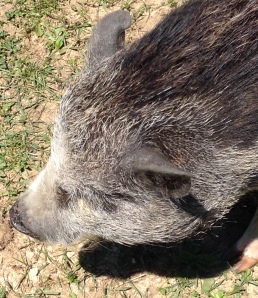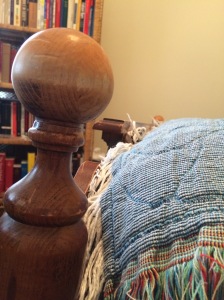
“So, who wants to feed the pig?”
I look around, my brother is already back with the horses. And my friend, who runs the farm I am currently spending time at, has important paperwork-like things to do. Slowly, I breath out.
“I guess I will.”
I take the white Styrofoam carryout box, containing the leftover French fries from our lunch plates, and make my way to a small barn. On its threshold, I unlatch the main stall gate and enter a world incensed by animal musk and sweet straw.
“Hey guys.”
I nod to an unblinking Alpine goat. When I turn to close the gate behind me, a grey haired donkey nuzzles my hip. With my free hand, I stroke his mane, tufted and wild.
“Sorry love, this isn’t for you.”
I pass by the goat and the friendly donkey, slipping between an iron gate and a wooden stall. I hear a delighted squeal and feel an eager prodding at my ankles. Taking another deep breath, I look down.
“Hey Lola, I’ve got something for you.”
She prods at my ankle again and I flinch. Her touch is concentrated and hard. I hope that I don’t bruise. Why did I agree to feed the pig? I’m afraid of pigs.
I first discovered this fear in college, during a spring break trip to a Heifer Project farm outside of Boston. The farm had two large hogs, who would eat everything from donuts to vegetables, and those two large hogs needed to go to the butcher’s. My classmates and I stood in two lines from pen to truck, behind thick boards that we fortified with our body weight. We hoped that the hogs would go quietly, but if they didn’t, only our body weight on the boards would keep the hogs from getting away—and us, from being trampled.
Shaking behind the board I braced, I realized that I was afraid. Pigs have a low center of gravity, are usually very muscular, and have one-track minds. Woe to those who get between them and their comfortable pen or their dinner of donuts. In order to meet their needs, to survive, they wouldn’t mind trampling you.
Or, in the case of Lola, bruising your ankles.
I stoop down and put my free hand on Lola’s nose.
“That’s enough, my girl.”
Surprisingly, she stops.
I sit on the straw and spread a handful of French fries in front of Lola. She snorts them up and then eagerly looks back up at me for more. Her actions are playful and energetic, almost dog-like. It isn’t long before the Styrofoam carryout box is empty.
Though Lola is finished with her snack, she isn’t finished with me. She turns around, carefully backing her stout little pig butt onto my lap. We sit together as I absently run my fingers along the black and white bristles on her back. Perhaps it isn’t pigs that I’m afraid of after all. Perhaps what makes me leery of them is their tendency to trample anything and everything to get what they want. Pigs can be dangerously selfish, but, as Lola is currently showing me, not all pigs are prone to bad behavior brought on by greed and desire.
And if I’m being honest in my musings, selfishness isn’t restricted to the actions of pigs.
I went to graduate school at a well-respected research university. Though my colleagues were not pigs, some of them had a tendency to show pig-like behavior in the presence of tenure-track positions, publishing deals, and eligible mates. I had to brace myself mentally and physically and politically from time to time, just so I wouldn’t get trampled in the name of someone else’s desires. And though I was strong and braced myself well, I was always very afraid.
No, it isn’t pigs that I fear. It’s the behavioral tendencies they’ve come to represent in my life. Thank goodness there is Lola though, whose sturdy little form feels like comfort and redemption and new beginnings as we sit in her stall filled with straw.
Note: The farm where the above took place is called Sand Hill Stable. It’s a beautiful horse stable and farm located in the outskirts of the Ohio Western Reserve. If you ever need to board horses in the area, or just want to visit a beautiful jewel of Northeastern Ohio countryside, contact the marvelous stable manager.
 Cleaning out my bookcases made me realize that when I have a disposable income, I waste it on books instead of clothing. In my youth, this habit made me quietly smug. I was not one of those shallow girls preoccupied with fashion and boys. Oh no, I was much better than that because I would buy books to read…and one day, I would impress some Austenesque fellow with my intellect and profound understanding of the world.
Cleaning out my bookcases made me realize that when I have a disposable income, I waste it on books instead of clothing. In my youth, this habit made me quietly smug. I was not one of those shallow girls preoccupied with fashion and boys. Oh no, I was much better than that because I would buy books to read…and one day, I would impress some Austenesque fellow with my intellect and profound understanding of the world.

